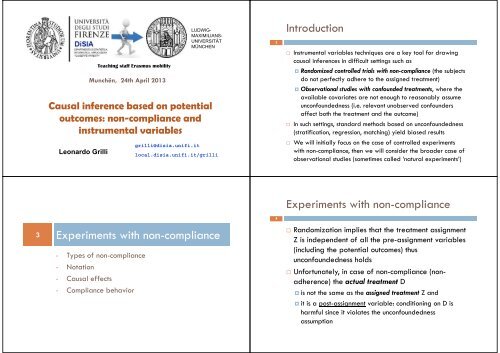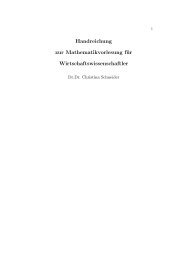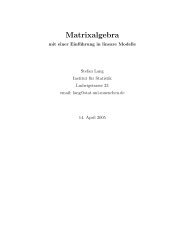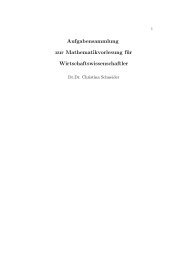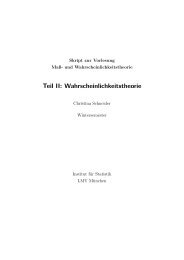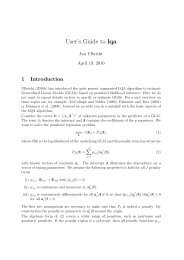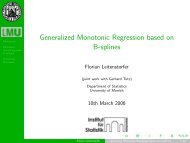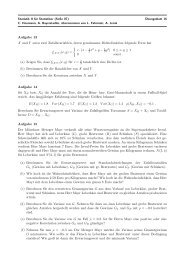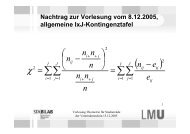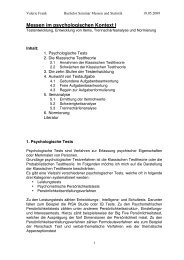ITT ITT
ITT ITT
ITT ITT
You also want an ePaper? Increase the reach of your titles
YUMPU automatically turns print PDFs into web optimized ePapers that Google loves.
Munchën, 24th April 2013<br />
Causal inference based on potential<br />
outcomes: non-compliance and<br />
instrumental variables<br />
Leonardo Grilli<br />
Teaching staff Erasmus mobility<br />
LUDWIG-<br />
MAXIMILIANS-<br />
UNIVERSITÄT<br />
MÜNCHEN<br />
grilli@disia.unifi.it<br />
local.disia.unifi.it/grilli<br />
2<br />
Introduction<br />
<br />
<br />
<br />
Instrumental variables techniques are a key tool for drawing<br />
causal inferences in difficult settings such as<br />
Randomized controlled trials with non-compliance (the subjects<br />
do not perfectly adhere to the assigned treatment)<br />
Observational studies with confounded treatments, where the<br />
available covariates are not enough to reasonably assume<br />
unconfoundedness (i.e. relevant unobserved confounders<br />
affect both the treatment and the outcome)<br />
In such settings, standard methods based on unconfoundedness<br />
(stratification, regression, matching) yield biased results<br />
We will initially focus on the case of controlled experiments<br />
with non-compliance, then we will consider the broader case of<br />
observational studies (sometimes called ‘natural experiments’)<br />
Experiments with non-compliance<br />
4<br />
3<br />
Experiments with non-compliance<br />
• Types of non-compliance<br />
• Notation<br />
• Causal effects<br />
• Compliance behavior<br />
Randomization implies that the treatment assignment<br />
Z is independent of all the pre-assignment variables<br />
(including the potential outcomes) thus<br />
unconfoundedness holds<br />
Unfortunately, in case of non-compliance (nonadherence)<br />
the actual treatment D<br />
is not the same as the assigned treatment Z and<br />
it is a post-assignment variable: conditioning on D is<br />
harmful since it violates the unconfoundedness<br />
assumption
Types of compliance<br />
Types of non-compliance /cont<br />
5<br />
Compliance can be<br />
Binary (all-or-none): e.g. the patient assigned to a<br />
new therapy only has two options: to participate or to<br />
not participate<br />
Partial: e.g. the patient assigned to a treatment<br />
entailing the take of one pill per day for 30 days may<br />
take 0 pills (she does not participate), or 30 pills (full<br />
compliance), or 0
Causal effects<br />
Compliance behaviour<br />
9<br />
10<br />
For a given individual in a given experiment, all the<br />
causal effects of Z on post-assignment variables are<br />
defined a priori in terms of potential outcomes<br />
Z on D: D(1) D(0)<br />
Z on Y: Y(1, D(1)) Y(0, D(0))<br />
Since Z is randomised both effects are estimable<br />
The average causal effect of Z on Y is known as<br />
Intention-To-Treat effect (<strong>ITT</strong>)<br />
1, (1) <br />
0, (0) <br />
<strong>ITT</strong> E Y D Y D<br />
In the <strong>ITT</strong> there is no conditioning on the value of D: each subject is left<br />
free to react to Z on the basis of her compliance behaviour<br />
<br />
Z and D binary 4 compliance states (types of<br />
reaction to treatment assignment)<br />
D(1) D(0) D(1)- D(0) Type Prob.<br />
1 0 1 Complier (C) C<br />
0 0 0 Never taker (NT) NT<br />
1 1 0 Always taker (AT) AT<br />
0 1 -1 Defier (D) D<br />
<br />
1<br />
C NT AT D<br />
Compliance behaviour /cont<br />
Latent and observable groups<br />
11<br />
12<br />
<br />
<br />
The labelling of individuals as C, NT, AT and D on the basis of<br />
the reaction to treatment assignment is<br />
Unobservable, i.e. the groups C, NT, AT and D are latent groups<br />
Relative to the behaviour of individuals in the actual experiment,<br />
not in general (e.g. a Never Taker in an experiment may be a<br />
Complier in another experiment)<br />
It is not affected by the actual assignment so it is a preassignment<br />
variable (this is a key property: since Z is<br />
randomised, the composition of the population in terms of<br />
compliance behaviour is the same at any level of Z)<br />
For AT and NT there is no information to estimate the causal<br />
effect of D on Y since Z is unable to change D<br />
General<br />
D obs<br />
Z 0 1<br />
0 NT /C AT /D<br />
1 NT /D AT /C<br />
Monotonicity<br />
( no Defiers)<br />
D obs<br />
Z 0 1<br />
0 NT /C AT<br />
1 NT AT /C<br />
Treatment available only to<br />
individuals assigned to<br />
treatment ( no D, no AT)<br />
D obs<br />
Z 0 1<br />
0 NT /C .<br />
1 NT C<br />
Membership to latent groups cannot be established (except for certain<br />
combinations of Z e D obs depending on the design)<br />
Nevertheless, if Z is randomised and the latent groups are no more than 3,<br />
we can estimate the probabilities of group membership (see next example)
Latent and observable groups /cont<br />
13<br />
Hypothetical experiment with random assignment Pr(Z=1)=0.5 and monotonicity<br />
Percentages of groups<br />
Assigned Control arm<br />
Treatment arm<br />
Population Taken Control Treatment Control Treatment<br />
50 Compliers 25 25<br />
30 Never Takers 15 15<br />
20 Always Takers 10 10<br />
100 Observed 40 10 15 35<br />
50 50<br />
The observed proportions allow us to recover the proportions of<br />
the 3 latent groups:<br />
Prop(AT) = 10/50 = 0.2 Prop (NT) = 15/50 = 0.3<br />
Prop(C) = 1-0.2-0.3 = 0.5<br />
14<br />
Complier Average Causal Effect<br />
• Definition of CACE<br />
• Estimation<br />
• Instrumental Variables<br />
• Comparison with Intention-To-Treat (<strong>ITT</strong>) effect<br />
• Traditional (and biased) estimators<br />
15<br />
CACE (or LATE)<br />
<br />
Data contain information to estimate the causal<br />
effect on the compliers, known as<br />
CACE = Complier Average Causal Effect, or<br />
LATE = Local Average Treatment Effect<br />
• Angrist J., Imbens G.W, Rubin D.B. (1996) Identification of<br />
Causal Effects using Instrumental Variables. JASA 91, 444-<br />
472.<br />
• Imbens, G.W. and Rubin, D.B. (1997) Bayesian inference for<br />
causal effects in randomized experiments with noncompliance.<br />
Annals of Statistics 25, 305–327, 1997.<br />
• Mealli F., and D.B. Rubin (2002) Assumptions when Analyzing<br />
Randomized Experiments with Noncompliance and Missing<br />
Outcomes. Health Services and Outcomes Research<br />
Methodology 3, 225-232.<br />
Joshua Angrist<br />
Guido Imbens<br />
Donald Rubin<br />
16<br />
From <strong>ITT</strong> to CACE<br />
Assume SUTVA<br />
<strong>ITT</strong> (Intention-To-Treat effect)<br />
<strong>ITT</strong> <strong>ITT</strong> <strong>ITT</strong> <strong>ITT</strong> <strong>ITT</strong><br />
<br />
C C NT NT AT AT D D<br />
<br />
<br />
<br />
<strong>ITT</strong>group E Y i<br />
1, Di (1) Yi 0, Di<br />
(0) | i group<br />
P i group<br />
group<br />
(essentially, SUTVA rules out interactions<br />
among units, so we can write expressions<br />
holding for a single, arbitrary unit)<br />
1, (1) <br />
0, (0) <br />
<strong>ITT</strong> E Y i<br />
Di Yi Di<br />
Decomposition of the <strong>ITT</strong> across the four latent compliance groups:
17<br />
Exclusion restriction<br />
Assume Exclusion restriction:<br />
Y(1, d) Y(0, d) for d 0,1<br />
i<br />
i<br />
• it rules out a direct effect of Z on Y (it captures the notion underlying<br />
instrumental variables procedures that any effect of Z on Y must be via<br />
an effect of Z on D)<br />
• it relates quantities that can never be jointly observed, thus it is not<br />
directly verifiable form the data (although it has testable implications)<br />
• it is violated in case of a placebo effect (indeed, placebo-controlled<br />
experiments, blinding and double-blinding aim at making the exclusion<br />
restriction more plausible)<br />
• the standard version of the exclusion restriction refers to all the units, and<br />
thus it applies to all the latent groups (compliers, never takers, etc.), but in<br />
some settings it may be useful to relax the exclusion restriction for a<br />
specific group, for example for the never takers<br />
18<br />
Exclusion restriction /cont<br />
The exclusion restriction has two consequences<br />
1. When Y is studied as a function of the actual treatment D,<br />
the assignment Z is superfluous, thus we can write<br />
Y d<br />
i<br />
( ) instead of Y( z, d)<br />
2. The <strong>ITT</strong> for never takers and always takers is null<br />
<strong>ITT</strong><br />
NT<br />
<strong>ITT</strong> 0<br />
The consequence #2 implies (along with SUTVA) that the<br />
decomposition of the <strong>ITT</strong> simplifies as follows:<br />
AT<br />
<strong>ITT</strong> <strong>ITT</strong> <br />
<strong>ITT</strong><br />
<br />
C C D D<br />
i<br />
Strong monotonicity<br />
CACE (or LATE)<br />
19<br />
Assume Strong monotonicity:<br />
1) Non-null average effect of Z on D<br />
E D(1) D(0) <br />
0<br />
<br />
i i C D<br />
2) Monotonicity (No defiers): <br />
Remark: 1 & 2 imply<br />
<br />
0<br />
<strong>ITT</strong> <strong>ITT</strong> C<br />
<br />
C C<br />
<br />
<br />
D<br />
E D(1) D(0) <br />
0<br />
i i C<br />
Part 1 states that Z moves D<br />
Part 2 states that Z only moves D in one direction<br />
Along with SUTVA and exclusion restriction, strong monotonicity implies that<br />
<br />
with 0<br />
20<br />
From the decomposition of the <strong>ITT</strong> in the last line of the previous slide,<br />
it follows that<br />
<strong>ITT</strong> EYi1, Di(1) Yi0, Di(0)<br />
<br />
CACE <strong>ITT</strong> <br />
<br />
C<br />
E D(1) D(0)<br />
C i i<br />
CACE is defined as the causal effect of D on Y for the unobservable<br />
group of compliers<br />
we have shown that, assuming (i) SUTVA, (ii) exclusion restriction and<br />
(iii) strong monotonicity, CACE is the ratio between two causal effects:<br />
the effect of Z on Y (<strong>ITT</strong>) and the effect of Z on D<br />
CACE is a population quantity: up to now we did not consider<br />
estimation (note: we did not invoke unconfoundedness or<br />
randomization of Z, since this relevant only for estimation)
21<br />
Estimation of CACE<br />
We have shown that under the assumptions (i) SUTVA, (ii)<br />
exclusion restriction and (iii) strong monotonicity<br />
<br />
<br />
<br />
<br />
<br />
<br />
<strong>ITT</strong> E Yi 1, Di(1) Yi 0, Di(0) EYi 1, Di(1) EYi 0, Di(0)<br />
<br />
CACE <br />
<br />
E D(1) D(0) E D(1) E D(0)<br />
C i i i i<br />
Under random assignment of Z, a consistent estimator of CACE is<br />
obtained by estimating the expected values using the<br />
corresponding sampling means:<br />
obs<br />
<br />
Y<br />
Z<br />
Y<br />
CACE D<br />
obs<br />
D<br />
obs<br />
[ 1] [ Z0]<br />
obs<br />
[ Z1] [ Z0]<br />
22<br />
<strong>ITT</strong> vs CACE<br />
<br />
If Z is randomized we can consistently estimate<br />
<strong>ITT</strong> (effect of Z on Y)<br />
• Whole population<br />
• Assumptions: SUTVA<br />
CACE (effect of D on Y)<br />
• Compliers (non-observable sub-population)<br />
• Assumptions: SUTVA, Exclusion restriction and Strong monotonicity<br />
If we are interested in the effect of D on Y, then CACE is more<br />
relevant than <strong>ITT</strong>, even if it requires stronger assumptions and it refers<br />
to a non-observable sub-population<br />
Advantages of <strong>ITT</strong><br />
Disadvantages of <strong>ITT</strong><br />
23<br />
<br />
<br />
<br />
<br />
Estimation of <strong>ITT</strong> is more robust than estimation of CACE since it<br />
is based on fewer assumptions<br />
Under the usual assumptions, CACE = <strong>ITT</strong>/pr(complier), thus<br />
|CACE| > |<strong>ITT</strong>|<br />
The <strong>ITT</strong> is a conservative estimate of CACE, so if we find a<br />
relevant <strong>ITT</strong> effect, there is also a relevant CACE effect<br />
The <strong>ITT</strong> estimate can be used to test the sharp null hypothesis<br />
of no causal effect (no effect will be declared when no effect<br />
exists)<br />
24<br />
<br />
<br />
<br />
The conservativeness of the <strong>ITT</strong> effect makes it a dangerous<br />
effect measure when the goal is evaluating a treatment’s<br />
safety (in fact, the <strong>ITT</strong> could be low because individuals assigned to new<br />
drug stopped taking it before developing serious adverse effects)<br />
The <strong>ITT</strong> effect is conservative in placebo-controlled trials, but it<br />
is not in experiments comparing two active treatments<br />
Since <strong>ITT</strong> = CACE pr(complier), the <strong>ITT</strong> effect mixes two<br />
components: the causal effect of interest and the compliance<br />
rate the <strong>ITT</strong> has a lower external validity than CACE
25<br />
Generalizing the <strong>ITT</strong><br />
<br />
<br />
The <strong>ITT</strong> summarizes the overall effect of an intervention it is<br />
important to generalize the <strong>ITT</strong> to other hypothetical<br />
experiments<br />
Since <strong>ITT</strong> = CACE pr(complier), generalizing the <strong>ITT</strong> entails<br />
generalizing the CACE and the compliance rate separately<br />
generalizing the CACE poses the usual difficulties for generalizing a<br />
causal effect (e.g. the effect may be influenced by the type of<br />
implementation, or by the features of the target population)<br />
the compliance rate may be rather different in another experiment (e.g.<br />
applying the intervention to a wider population usually entails a lower<br />
compliance rate; e.g. if the treatment has proved to be effective, in<br />
future experiments there will likely be a higher compliance rate);<br />
moreover, increasing the compliance rate could be a feasible policy<br />
goal<br />
26<br />
Instrumental variables (IV)<br />
A variable Z is called instrument if it<br />
satisfies two conditions:<br />
• Relevance: Z affects the endogenous<br />
regressor D (hence the arrow Z D)<br />
• Exclusion restriction: Z affects Y only<br />
through D (the only path from Z to Y<br />
passes through D)<br />
The idea underlying Instrumental Variables is that the<br />
relationship between the outcome Y and the<br />
endogenous regressor D (affected by omitted<br />
variables U) can be estimated without bias by<br />
exploiting the part of variability of D that is<br />
uncorrelated with the omitted variables, namely the<br />
variability of D induced by the instrument Z<br />
Z<br />
<br />
OLS<br />
U<br />
D Y<br />
cov( Y, D) cov( Y, D)<br />
<br />
var( D) cov( DD , )<br />
<br />
IV<br />
cov( Y, Z)<br />
<br />
cov( D, Z)<br />
CACE and instrumental variables (IV)<br />
Natural experiments<br />
27<br />
<br />
<br />
<br />
<br />
The CACE (or LATE) estimator is equal to the IV estimator<br />
Indeed, when the IV variable is binary the IV estimator of the<br />
effect of D on Y has the following expression (Wald)<br />
<br />
obs<br />
obs obs<br />
cov( Yi<br />
, Z ) Y<br />
i [ Z1] Y[ Z0]<br />
IV CACE<br />
<br />
cov( obs<br />
obs obs<br />
D , Z ) D D<br />
i<br />
i<br />
[ Z1] [ Z0]<br />
The IV estimator has been introduced in Econometrics a long<br />
time ago (Philip G. Wright, 1928), but the interpretation in terms<br />
of potential outcomes is recent (Imbens & Angrist, 1994)<br />
Under the assumptions (i) SUTVA, (ii) exclusion restriction and<br />
(iii) strong monotonicity, the IV estimator is estimating the CACE,<br />
a quantity with a valid casual interpretation<br />
28<br />
<br />
<br />
Instrumental variables are generated by randomized<br />
experiments and also by natural experiments, namely<br />
“situations where the forces of nature or government policy<br />
have conspired to produce an environment somewhat akin to a<br />
randomized experiment.” (Angrist & Kruger, 2001)<br />
An example of natural experiment is the lottery for draft for<br />
the U.S. army (Angrist, Imbens, Rubin 1996) illustrated later<br />
Imbens, Guido W. and Joshua D. Angrist (1994). Identification and Estimation of Local<br />
Average Treatment Effects. Econometrica. 62(2), 467-75.<br />
Angrist, J. and A. Krueger (2001) Instrumental variables and the search for<br />
identification: From supply and demand to natural experiments, Journal of Economic<br />
Perspectives, 15(4), 69–85.
Looking for instrumental variables<br />
29<br />
Angrist & Kruger (2001) wrote:<br />
<br />
<br />
<br />
A good instrument is correlated with the endogenous regressor<br />
for reasons the researcher can verify and explain, but<br />
uncorrelated with the outcome variable for reasons beyond its<br />
effect on the endogenous regressor.<br />
Maddala (1977, p. 154) rightfully asks, "Where do you get<br />
such a variable?" Like most econometrics texts, he does not<br />
provide an answer.<br />
In our view, good instruments often come from detailed<br />
knowledge of the economic mechanism and institutions<br />
determining the regressor of interest.<br />
30<br />
Examples<br />
• Artificial example<br />
• Lottery for draft – U.S. army<br />
31<br />
Traditional (and biased) estimators<br />
As-treated estimator:<br />
Per-protocol estimator:<br />
Y<br />
Y<br />
Y<br />
obs obs<br />
obs<br />
[ D 1] obs<br />
[ D 0]<br />
Y<br />
[ Z1, D 1] [ Z0, D 0]<br />
Those estimators are very simple but generally biased: in fact,<br />
they condition on D, which is a post-treatment variable<br />
WARNING: Unconfoundedness ensures the balancing across<br />
treatment groups for pre-treatment variables but not for posttreatment<br />
variables<br />
obs<br />
obs<br />
obs<br />
obs<br />
Example<br />
Hypothetical experiment with random assignment Pr(Z=1)=0.5 and (i) SUTVA, (ii)<br />
exclusion restriction and (iii) strong monotonicity<br />
Percentages of groups<br />
Mean outcome<br />
Assigned Control arm Treatment arm Control arm Treatment arm<br />
Population Taken Control Treatment Control Treatment Control Treatment Control Treatment<br />
50 Compliers 25 25 500 600<br />
30 Never Takers 15 15 480 480<br />
20 Always Takers 10 10 550 550<br />
100 Observed 40 10 15 35 492.5 550.0 480.0 585.7<br />
50 50<br />
504.0 554.0<br />
obs obs<br />
Mean of treated 577.8<br />
As-treated: Y obs Y<br />
obs<br />
[ D 1] [ D 0]<br />
Mean of control 489.1<br />
Per-protocol:<br />
As-treated effect 88.7<br />
obs<br />
obs<br />
Y obs Y<br />
Per-protocol effect 93.2<br />
obs<br />
[ Z1, D 1] [ Z0, D 0]<br />
Intention-to-treat effect 50.0<br />
obs obs<br />
Proportion of compliers 0.5<br />
Intention-to-treat: Y[ Z1] Y[ Z0]<br />
CACE 100.0<br />
<strong>ITT</strong> is an underestimate of CACE (lower proportion of compliers higher bias)<br />
The As-treated and Per-protocol effects are over- or under-estimates of CACE<br />
depending on the mean outcome of Never Takers and Always Takers (see next ex.)
Example (mean outcome AT: from 550 to 650)<br />
Hypothetical experiment with random assignment Pr(Z=1)=0.5 and (i) SUTVA, (ii)<br />
exclusion restriction and (iii) strong monotonicity<br />
Percentages of groups<br />
Mean outcome<br />
Assigned Control arm Treatment arm Control arm Treatment arm<br />
Population Taken Control Treatment Control Treatment Control Treatment Control Treatment<br />
50 Compliers 25 25 500 600<br />
30 Never Takers 15 15 480 480<br />
20 Always Takers 10 10 650 650<br />
100 Observed 40 10 15 35 492.5 650.0 480.0 614.3<br />
50 50<br />
524.0 574.0<br />
As-treated:<br />
Per-protocol:<br />
Intention-to-treat:<br />
Y<br />
Y<br />
Y<br />
Y<br />
obs obs<br />
obs<br />
obs<br />
[ D 1] [ D 0]<br />
obs<br />
obs<br />
obs Y<br />
obs<br />
[ Z1, D 1] [ Z0, D 0]<br />
obs obs<br />
[ Z1] Y[ Z0]<br />
Mean of treated 622.2<br />
Mean of control 489.1<br />
As-treated effect 133.1<br />
Per-protocol effect 121.8<br />
Intention-to-treat effect 50.0<br />
Proportion of compliers 0.5<br />
CACE 100.0<br />
34<br />
Example: lottery for draft – U.S. army /1<br />
<br />
<br />
<br />
AIR 1996: Angrist J., Imbens G.W, Rubin D.B., 1996. Identification of Causal<br />
Effects using Instrumental Variables. JASA 91, 444-472.<br />
In the years1970-1973, draft to U.S. army for Vietnam war was based on<br />
a lottery:<br />
For any cohort, each date of birth was randomly assigned a number<br />
from 1 to 365<br />
Males with a number lower than a certain threshold were drafted, e.g.<br />
males born in 1950 were called to be drafted until the number 195<br />
Variables:<br />
Z = 1 if the individual had a number lower than the threshold (i.e. he<br />
was called to be drafted)<br />
D = 1 if the individual actually drafted<br />
Y = 1 if the individual died in the period 1974-1983 (civilian mortality,<br />
i.e. for causes not directly related to war)<br />
Example: lottery for draft – U.S. army /2<br />
Estimates and comments from AIR 1996 p 453<br />
35<br />
<br />
The assumptions for a valid causal interpretation of the IV estimand are<br />
(AIR 1996 p 452):<br />
SUTVA: The veteran status of any man at risk of being drafted in the<br />
lottery was not affected by the draft status of others at risk of being<br />
drafted, and, similarly, that the civilian mortality of any such man was<br />
not affected by the draft status of others<br />
Ignorable Assignment: Assignment of draft status was random<br />
Exclusion restriction: Civilian mortality risk was not affected by draft<br />
status once veteran status is taken into account<br />
Nonzero Average Causal Effect of Z on D: Having a low lottery<br />
number increases the average probability of service<br />
Monotonicity assumption: There is no one who would have served if<br />
given a high lottery, but not if given a low lottery number<br />
Some men with low lottery numbers changed their educational plans so as to retain draft<br />
deferments and avoid the conscription. If so, then the exclusion restriction could be violated, because<br />
draft status may have affected civilian outcomes through channels other than veteran status.<br />
(men born in 1950)<br />
Of the men with low lottery numbers (Z = 1), 35.3% actually served in the military. Of those<br />
who had high lottery numbers (Z = 0), only 19.3% served in the military. Random assignment of<br />
draft status suggests that draft status had a causal effect that increased the probability of<br />
serving by an estimated 15.9% on average.<br />
Similarly, of those with low lottery numbers, 2.04% died between 1974 and 1983, compared<br />
to 1.95% of those who had high lottery numbers. The difference of 0.09% can be interpreted<br />
as an estimate of the average causal effect of draft status on civilian mortality.<br />
Assuming that these estimated causal effects are population averages, the ratio of these two<br />
causal effects of draft status is, under the Assumptions 1-5, the causal effect of military service<br />
on civilian mortality for the 15.9% who were induced by the draft to serve in the military. For<br />
this group, the average causal effect is 0.56%.
Example: lottery for draft – U.S. army /4<br />
Further references<br />
37<br />
38<br />
This application highlights the fact that the IV<br />
estimator does not require observations on<br />
individuals; sample averages of outcomes and<br />
treatment indicators by values of the instruments are<br />
sufficient<br />
In addition, in this application, the sample averages<br />
for computing the IV estimator are drawn from<br />
different data sets<br />
<br />
<br />
<br />
<br />
<br />
<br />
Jo, B. (2002) Estimation of intervention effects with noncompliance: Alternative<br />
model specifications. JEBS, 27, 385–409.<br />
Mealli F., G. Imbens, S. Ferro, A. Biggeri (2004) Analyzing a Randomized Trial on<br />
Breast Self Examination with Noncompliance and Missing Outcomes, Biostatistics, 5,<br />
2, 207-222.<br />
Jo B., Asparouhov T. & Muthén B. (2008) Intention-to-treat analysis in cluster<br />
randomized trials with noncompliance. Statistics in Medicine, 27, 5565–5577<br />
Little, R., Long, Q., & Lin, X. (2009) A comparison of methods for estimating the<br />
causal effect of a treatment in randomized clinical trials subject to noncompliance.<br />
Biometrics, 65, 640–649.<br />
Schochet P.Z. & Chiang H.S. (2011) Estimation and Identification of the Complier<br />
Average Causal Effect Parameter in Education RCTs. JEBS, 36, pp. 307–345.<br />
Frumento P., Mealli F., Pacini B., and Rubin D.B. (2012) Evaluating the Effect of<br />
Training on Wages in the Presence of Noncompliance, Nonemployment, and Missing<br />
Outcome Data, Journal of the American Statistical Association, 107, 450-466.


